
12 Spanish Festivals You Simply Must Experience
Expat Tips
Published: 16 September 2020 13:19 CET
Updated: 10 April 2025 13:19 CET
One of the things you notice when living in Spain is the sheer number of festivals that take place throughout the year.
Many of the festivals in Spain are local traditions and are only celebrated in specific towns or regions of the country, although many take place nationally.
Experiencing any Spanish festival will give you the opportunity to integrate with the locals and gain a greater understanding of what makes this wonderful and vibrant country tick.
Many of the festivals in Spain coincide with the public and school holidays so it’s the perfect opportunity to enjoy some family time together.
Below we list some of the most popular and traditional festivals in Spain for 2025 you will most definitely want to visit whilst on your travels.
6th January: - Three Kings Day
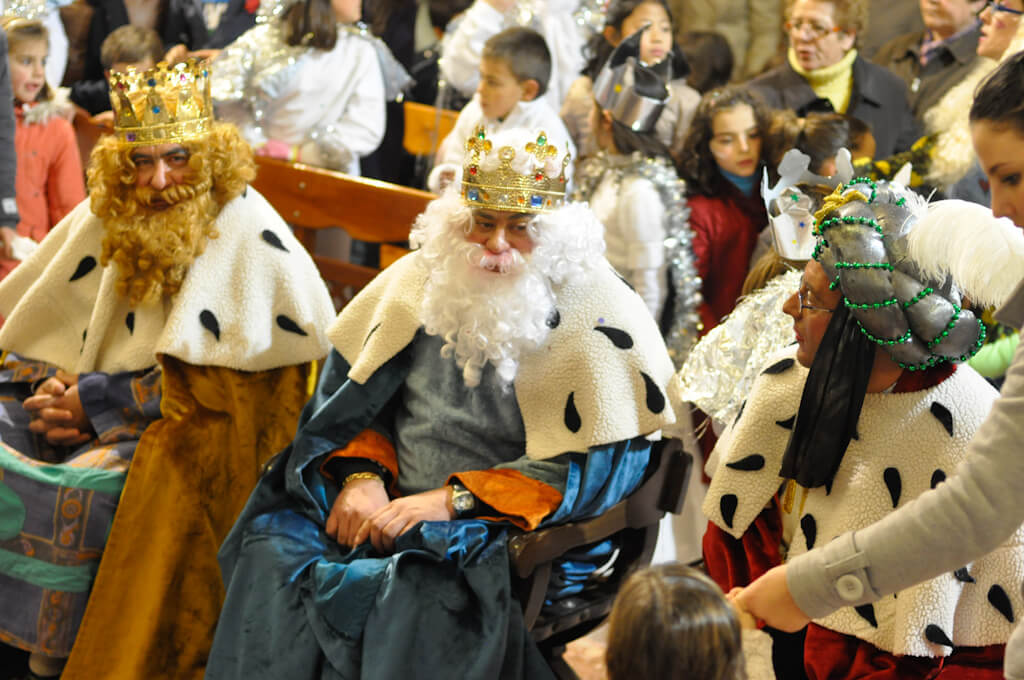
Image Credit: SH Madrid
One of the most famous Spanish festivals is the Three Kings Day or “Dia de Los Reyes”.
Three Kings Day (Epiphany) is the day in which Spanish children receive their Christmas presents from the three wise men who deliver them to their homes at night much like Santa Claus does for those in the UK.
However, the main procession (Cabalgate de Reyes) takes place the night before and is where up and down the country in the major towns and cities, the three wise men parade through the streets on colourful floats, throwing sweets and other confectionery into the crowds.
Further information here: Epiphany (Three Kings Day)
1st-19th March: Las Fallas, Valencia
The Las Fallas festival takes place over a two-week period each year and is most definitely one of Spain’s most famous festivals.
Las Fallas combines tradition, satire, and art in the form of hundreds of giant Ninots (dolls or puppets) which depict modern-day celebrities, politicians and other icons along with more traditional Spanish figures.
From around 2 pm each day, you can watch amazing shows with music and fireworks, however, the biggest spectacle takes place on the last night when all the Ninots come to a terrible end when the locals set fire to them.
The origin of the festival is said to come from an old carpenter’s tradition that used to celebrate the beginning of Spring on March 19, by burning pieces of wood which they used to prop up their lights during winter.
This particular Spanish festival is an unmissable event for the whole family and is so special that it has been recognised by UNESCO as an event of ‘Intangible Cultural Heritage of Humanity’.
Further information here: Fallas Festival in Valencia
13th-20th April: Holy Week (Semana Santa)
Holy Week or Semana Santa is one of Spain’s most important religious festivals and takes place for one week over the last week of Lent.
The whole week is full of elaborate penance processions with floats or thrones bearing statues of Mary and Jesus. You will also see members of the different Catholic brotherhoods dressed in long robes and pointed hats followed by women dressed in black and holding candles.
The whole thing may sound a little bizarre for most of us, and whether you are religious or not, it’s an occasion that you should experience at least once. Some of the most lively and glamorous celebrations can be seen in Malaga, Granada, and Seville.
The Easter festival is very important to Spaniards with many families taking the streets with chairs and obligatory snacks and refreshments ready to enjoy the festivities.
Find out more: Holy Week in Spain
4th-10th May - : Feria de Abril, Sevilla
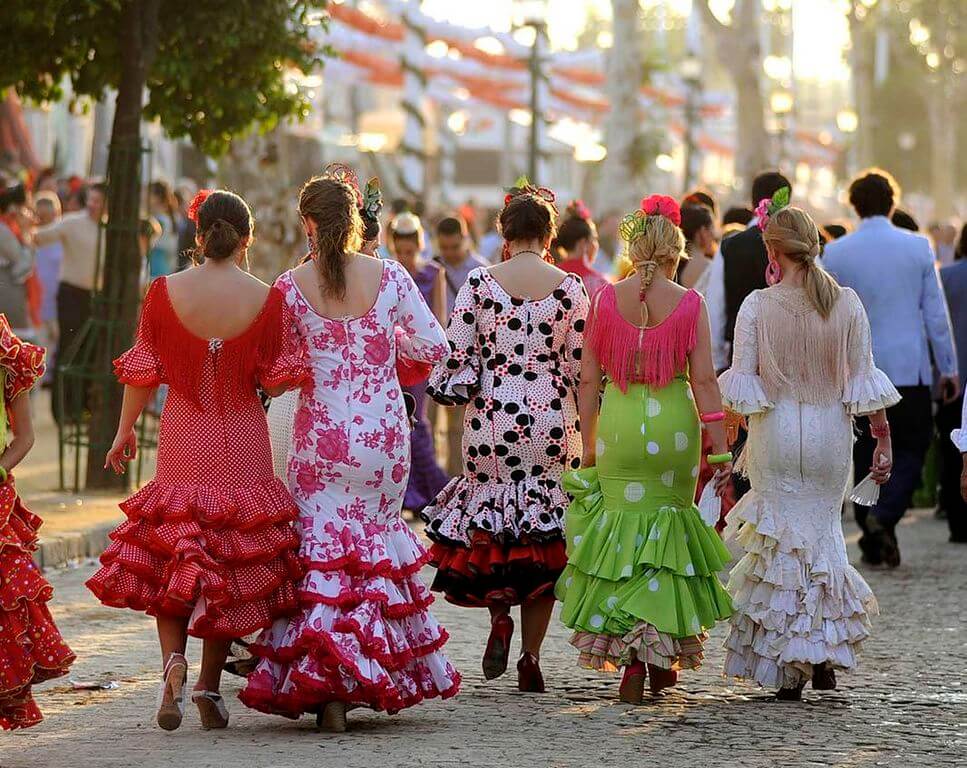
Image Credit: Sevilla Congress & Convention Bureau / CC BY-SA
Following on from Semana Santa comes another Seville festival which is the Feria de Abril.
The Feria de Abril usually starts two weeks after Semana Santa and lasts for one week. The Seville feria is a beautiful and traditional festival that dates as far back as 1846.
The Feria de Abril is a joyous event where the locals will drink copious amounts of alcohol, eat lots of tapas, and dance until the early hours.
There is always a number of both public and private food tents (Casetas) where you can refuel while mingling with the locals. There is also an amusement/theme park where you can enjoy many of the rides and games.
The festival sees many of the locals riding horses and pulling carriages while dressed up in traditional Andalusian costumes. It is a fabulous site and a great opportunity for some photographs.
More information on Seville’s April Fair
23rd April: Diada de Sant Jordi, Barcelona
Like the English, the Catalans also have a patron saint who goes by the slightly different name of Sant Jordi (Saint George).
The Diada de Sant Jordi is a little like Valentine’s Day, with the whole of the famous Las Ramblas turned into a sea of bloom. It’s said that the men have to purchase a rose for their partner who in return have to buy their man a book. It’s said that the gesture comes from the fact that Spain’s most famous writer, Miguel Cervantes died on this day.
The giving of the rose has been a tradition on this day since medieval times, however, the gifting of a book is a more recent addition, originating in 1923.
The day is also commonly known as El Dia de la Rosa (Day of the Rose) and El Dia del Libre (Day of the Book).
Further information: Sant Jordi Festival in Barcelona
17th-24th May: Feria de Jerez (Feria del Caballo)
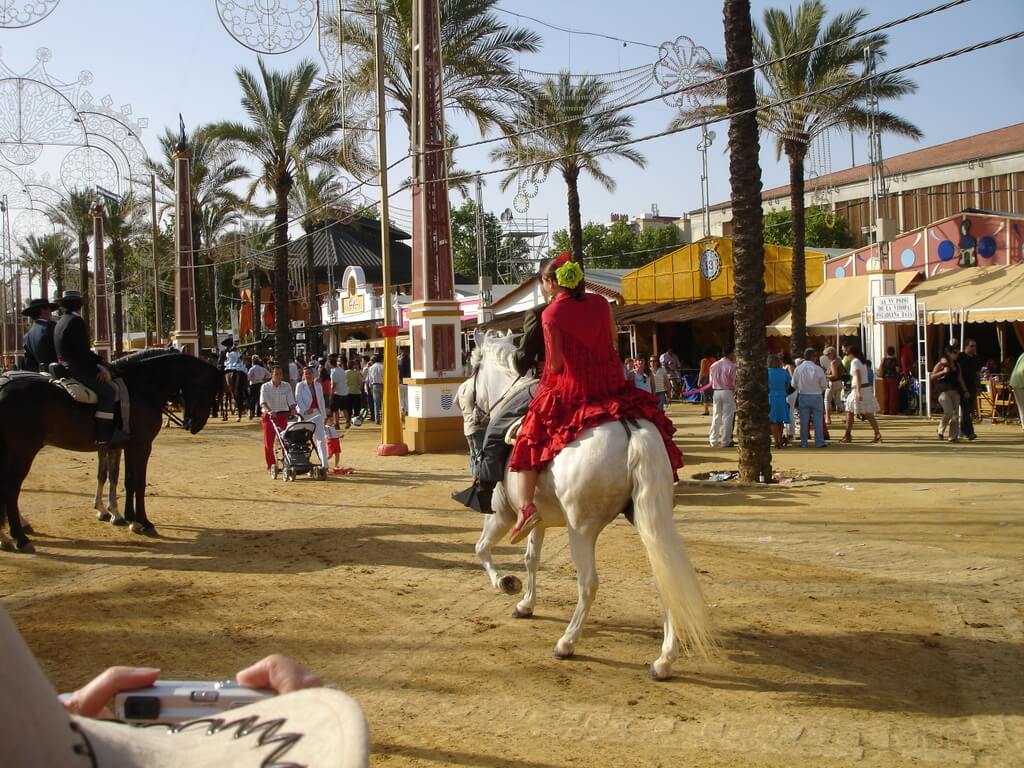
Image Credit: El Pantera / CC BY-SA
Usually held in the first or second week of May, the Feria de Jerez which is also known as the Feria del Caballo (Horse Fair) is one of Andalusia’s most famous feria and showcases everything this wonderful region has to offer.
Located in the municipality of Jerez de la Frontera the festival is held in the Parque González Hontoria.
The event is said to have originated in medieval times when farmers would meet to trade their horses and other livestock. They would then down a few drinks (sherry no doubt) to celebrate the deals.
The event is split in two with a number of bars and restaurants known as Casetas offering refreshments including traditional Spanish tapas. Then there is the theme park area where both adults and younger children can enjoy the rides including Ferris wheels and dodgems. You will also be able to watch horse parades and traditional Andalusian flamenco dancing displays.
More info here: Feria de Jerez (Jerez May Horse Fair)
15th May: Fiesta de San Isidro, Madrid
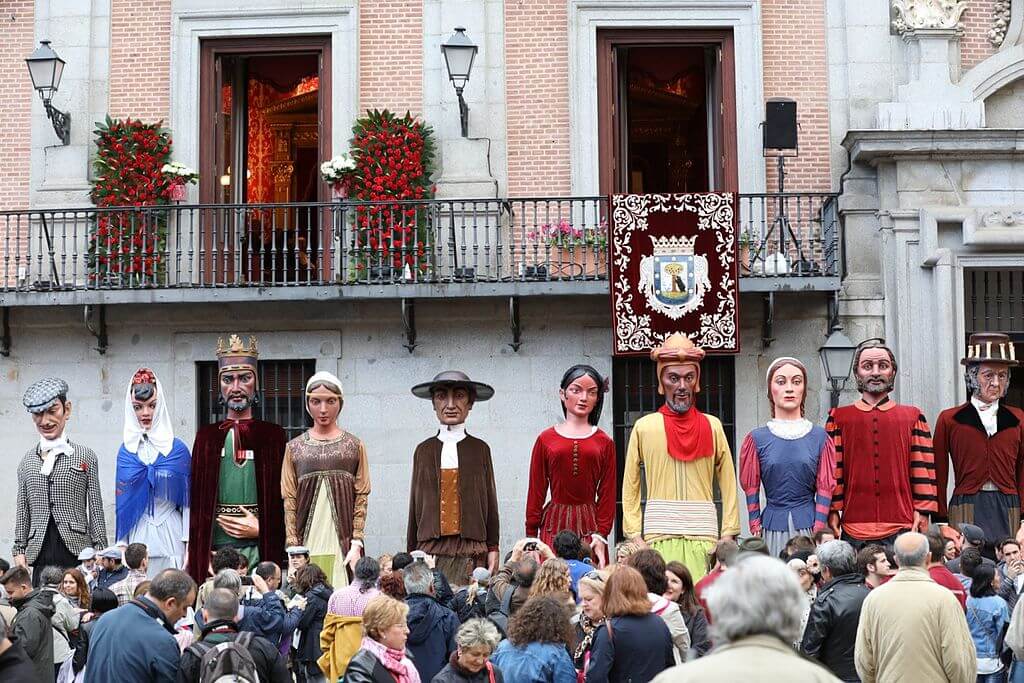
Image Credit: Diario de Madrid / CC BY
The Fiesta de San Isidro is Madrid’s biggest and most colourful festival and takes place on May 15 with the days running up to it the perfect opportunity to savour the traditions of Madrid.
Every year, Madrileños dress up and dance the traditional chotis in the streets and pay homage to the city’s patron saint, San Isidro Labrador.
The festivities last for a week and feature music, dancing, shows and a wide range of activities for everyone to enjoy in the city’s public spaces and the park named after the saint, Pradera de San Isidro.
More info here: San Isidro Festival in Madrid
July 29: Near Death Experience Festival, Neves
This Spanish festival is a little odd, to say the least!
The Fiesta de Santa Marta de Ribarteme or ‘Near-Death Experience Festival’ is held every year in the small Spanish village of Neves.
Santa Marta de Ribarteme is the patron saint of resurrection and the festival is a celebration of those who have had a close shave in the last 12 months.
The fortunate survivors are carried through the town in open coffins by family members who are often dressed as though they were going to a funeral!
Although the main event is a little morbid, there are festivities afterward that go on into the following day and of course, involve plenty of alcoholic beverages, food, and the obligatory firework display.
Find out more here: Fiesta de Santa Marta de Ribarteme
16th-24th August: Aste Nagusia - Semana Grande, Bilbao
Held at the end of August, The Aste Nagusia, Semana Grande or ‘Big Week’ is Bilbao’s biggest festival and stretches over 9 days.
The festival begins on the Saturday when crowds gather at the iconic Arriaga Theatre on the banks of the Nervion River.
The event starts when a rocket called a Txupinazo is fired into the sky and the event’s mascot Marijaia, appears on the balcony.
Then follows a whole host of events including traditional Basque music and dancing with the streets lined with tents offering traditional Spanish food and drink. Children will especially enjoy the parade of giants or ‘Gargantua’ And for the kids, there is the parade of giants and the Gargantua as well as nightly firework displays to enjoy.
At the end of the festival, the mascot Maijaia is set on fire to bring the celebrations to an end.
Further info here: Aste Nagusia (Semana Grande) in Bilbao
16th-23rd August: Feria de Malaga
A festival in Spain definitely not to be missed is the Malaga fair which lasts over 10 days with music, flamenco dancing, food, and lots of fun-packed events.
The event is massive and features concerts, rides, fireworks, and lots more. The festival is said to commemorate Malaga becoming a part of the Kingdom of the Castille when King Ferdinand and Queen Isabella conquered Malaga in 1487.
The fair is one of the most popular in Spain and has been celebrated since 1491.
The Malaga Fair is definitely one not to miss! Find out more here: Feria de Málaga
24th August: Boloencierro in Mataelpino, Madrid
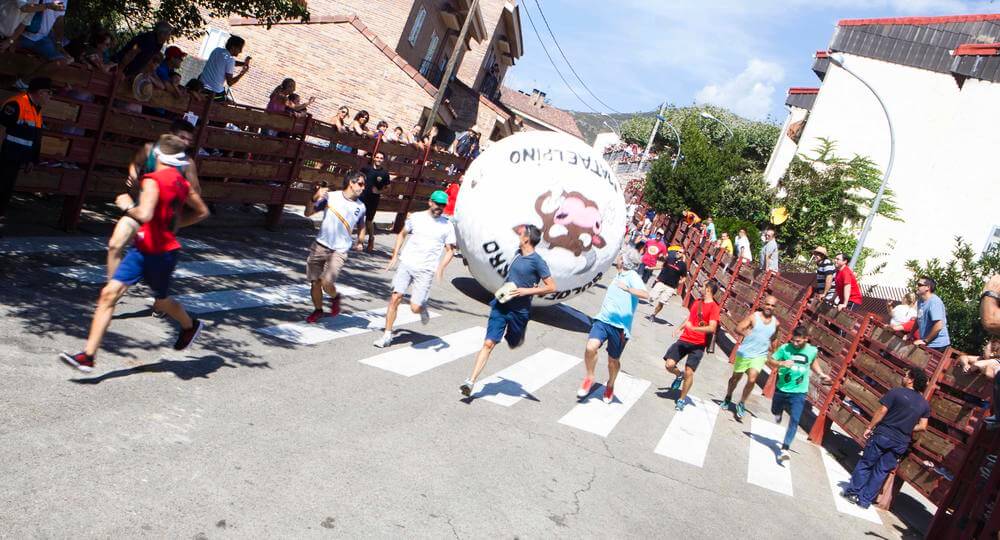
Image Credit: Turismo BCM
Not so much ‘running of the bulls’ but ‘running of the balls’, the Boloencierro is exclusive to the town of Mataelpino, a village in the Sierra de Guadarrama.
In 2011, the cash-strapped town couldn’t afford to host a more traditional style bull run so looked for another way to continue to host the event without the usual expense.
Mayor, Javier de los Nietos is said to have been the one to come up with the idea of the name Boloencierro a combination of the Spanish words "bolo" or ball and "encierro" or bull run.
During the Boloencierro, a 3-metre wide, 150-kilo foam ball is rolled down the street with the objective being to avoid it at all costs. There is also an event for the little one’s featuring a smaller ball so that everyone has the opportunity to get involved.
The lovely thing about El Boloencierro is that nobody gets gored and no bulls are killed unnecessarily. A win-win all round! In fact, a number of other towns in Spain have already joined the revolution and have begun hosting their own Boloencierro festivals.
The experience is open to everyone, so if you’re brave enough to be chased by a massive expanding foam ball, head to this particular corner of Madrid.
If you are looking for a small but very traditional festival to enjoy, the Boloencierro is a must-see (and do) experience.
Check it out here: Running of the Bulls (San Fermín Festival)
27th August: La Tomatina, Buñol
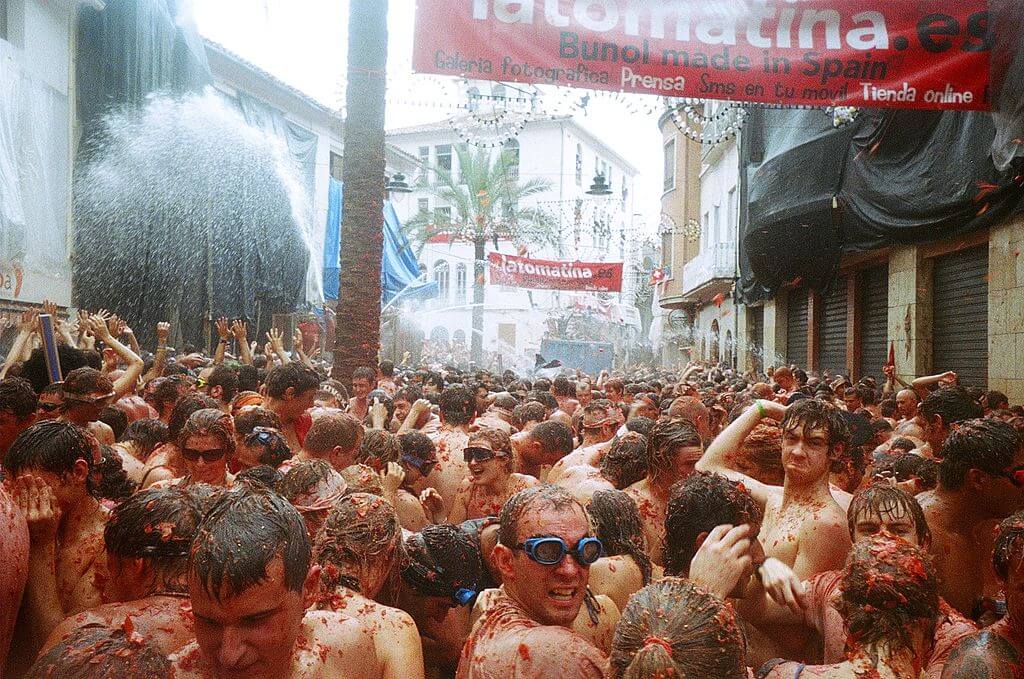
Image Credit: Graham McLellan from London, UK / CC BY
Food fight anyone?
If you like tomatoes and have the urge to throw them at others (why wouldn’t you?), then the famous La Tomatina festival in Buñol, Valencia is for you.
La Tomatina has been running for over 75 years and attracts thousands of people each year to the small town to take part in what is one of Spain’s wackiest festivals.
The main event only lasts for around one hour and it’s every man and woman for themselves as trucks transport tons of tomatoes from Extremadura into the town's Plaza del Pueblo. It’s said that the festival only begins when someone gets to the top of a large greasy wooden pole and reaches the smoked ham at the top, although in most cases people are too impatient to wait so long. So it all kicks off regardless!
Although the event used to welcome around 50,000 tomato chuckers, the numbers were restricted to just 20,000 in 2013. Today, anyone wishing to take part will have to purchase a ticket to join in the festivities.
Further info here: La Tomatina (Tomato Throwing Festival)
Although there are many more festivals in Spain to enjoy, the 12 above cover some of the most popular and should give you ample opportunity to experience Spain’s fiestas.






















